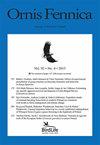丹麦红背伯劳的繁殖生物学:分布、性能和雏鸟后的生存
IF 1.2
4区 生物学
Q2 ORNITHOLOGY
引用次数: 0
摘要
自20世纪以来,整个欧洲的农业集约化和栖息地退化导致适应开阔景观的鸟类数量下降,例如红背伯劳鸟(Lanius collurio)。有效的保护策略需要了解物种的繁殖生物学。为了更好地了解丹麦繁殖种群的状况,我们调查了影响其繁殖参数的因素(即分布、性能、雏鸟后存活率和行为)。我们对羽化后时期的关注解决了目前的知识差距,这是由于雀形目动物繁殖周期中这一尚未充分研究的重要阶段。我们利用丹麦公民科学数据,辅以新西兰和北日德兰半岛(丹麦)当地项目的数据,研究了不同栖息地类型的繁殖对。在农业生境中较少,而在森林、半自然开放生境和共生生境中较多。2000年至2021年的数据显示,与农业或半自然开放栖息地相比,森林中的成对繁殖能力明显更高。一些项目地点的雏鸟数量明显高于其他项目地点,表明这些地点是潜在的繁殖生产力核心区。在过去的二十年里,丹麦的平均繁殖生产力稳定在每对成功的雏鸟2.3只。带环的雏鸟在羽化后的时期存活率增加,可能是由于它们的行为更加活跃和独立。本研究中发现的相对较低的繁殖生产力需要进一步的研究,包括来自农业等潜在次要栖息地的详细数据,以了解栖息地对人口波动的影响。本文章由计算机程序翻译,如有差异,请以英文原文为准。
Breeding biology of Red-backed Shrikes (Lanius collurio): distribution, performance and post-fledging survival in Denmark
Agricultural intensification and habitat degradation across Europe have caused declines since the 20th century in populations of birds adapted to open landscapes, such as the Red-backed Shrike (Lanius collurio). Effective conservation strategies require knowledge on species’ breeding biology. To understand the status of the Danish breeding population better, we investigate which factors affect their breeding parameter (i.e. distribution, performance, post-fledging survival and behaviour). Our focus on the post-fledging period addresses present knowledge gaps due to the importance of this, yet under-studied, phase of passerines’ breeding cycle. We studied breeding pairs on different habitat types with Denmark-wide Citizen Science data, complemented by data of local projects in Northern Zealand and Northern Jutland (Denmark). Significantly fewer pairs were found in agricultural habitats and more in forests, semi-natural open habitats and synanthropic habitats. Pairs in forests had a significantly higher breeding productivity compared to agricultural or semi-natural open habitats for data from the years 2000 to 2021. Some project sites showed significantly higher number of fledglings compared to others, indicating that these sites are potential core areas for breeding productivity. Over the last two decades, the mean breeding productivity across Denmark was stable with 2.3 fledglings per successful pair. The survival rate of ringed fledglings increased during the post-fledging period, likely due to their increase in more active and independent behaviour. The relatively low breeding productivity found in this study calls for further studies including detailed data from potentially secondary habitats like agricultural areas to understand the effects of habitat on population fluctuations.
求助全文
通过发布文献求助,成功后即可免费获取论文全文。
去求助
来源期刊

Ornis Fennica
生物-鸟类学
CiteScore
2.00
自引率
0.00%
发文量
14
审稿时长
>12 weeks
期刊介绍:
Ornis Fennica is a peer-reviewed international ornithological journal published by BirdLife Finland. Ornis Fennica publishes analytical and experimental papers on the ecology, behaviour and biogeography of birds. Ornis Fennica prefers studies concerning Fennoscandian species, but other novel contributions of general interest are most welcome as well.
Ornis Fennica is an open-access journal without page charges for publication. All published articles (from 1924 onwards) are freely available from the journal website. First decisions are usually made within three months of submission.
 求助内容:
求助内容: 应助结果提醒方式:
应助结果提醒方式:


